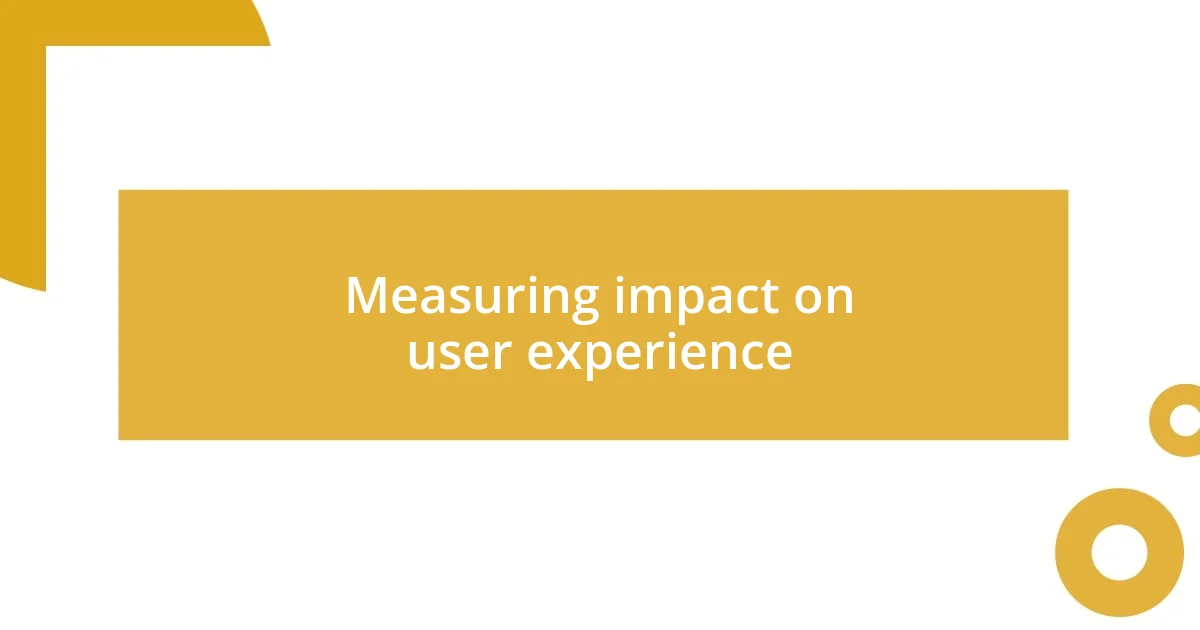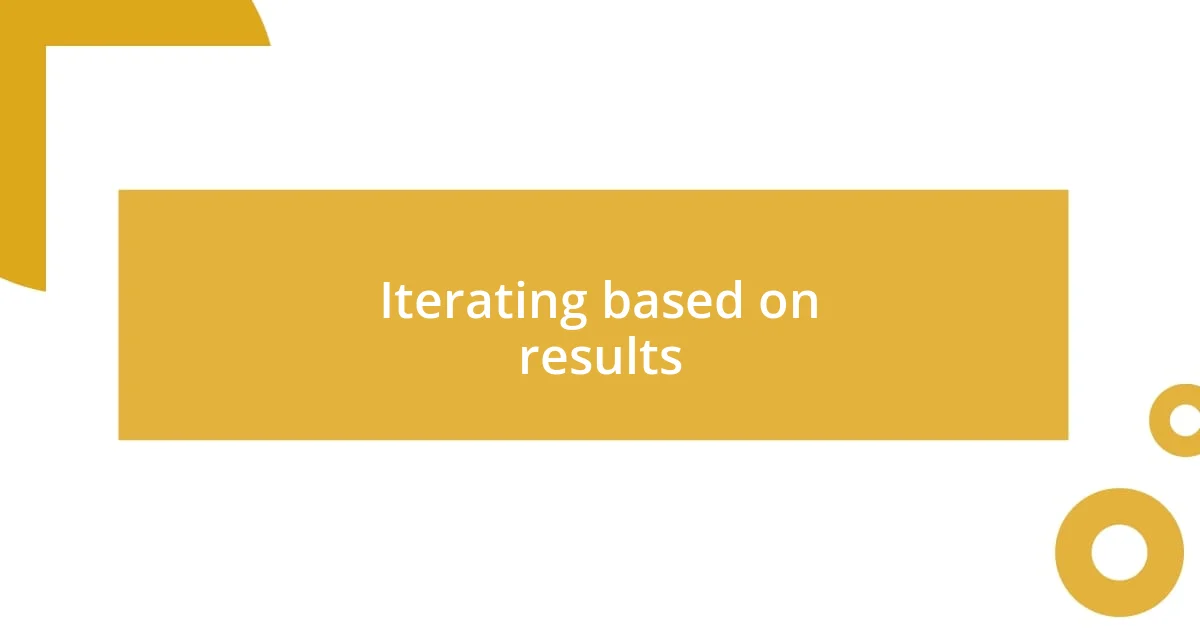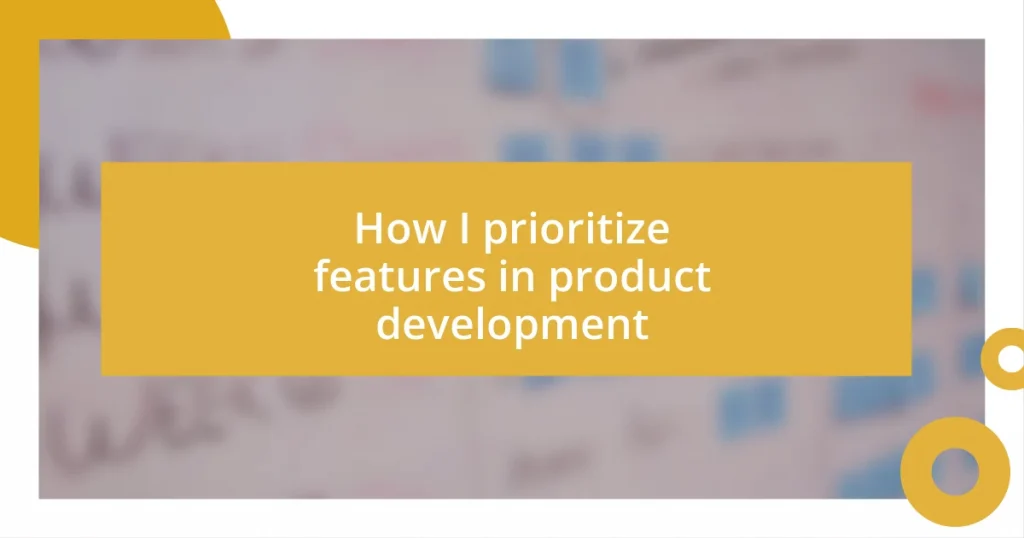Key takeaways:
- Feature prioritization is a strategic decision influenced by user needs and company values, requiring ongoing reflection and dialogue.
- User feedback is essential for guiding feature prioritization, helping teams understand emotions behind data and enabling product innovation.
- Iterating based on results fosters a culture of continuous improvement, ensuring products align with user expectations and enhancing overall user experience.

Understanding feature prioritization
Feature prioritization isn’t just about choosing which features to build; it’s a strategic decision that can make or break a product’s success. I remember a project where we had a limited budget and time. Faced with a long list of requested features, I asked the team, “What is the one feature that will give our users the most value right now?” That question shifted our focus and led us to prioritize what really mattered.
When I think about the different methods of prioritization, I often find myself reflecting on the emotional connection we have with our users. How can we align their needs with our goals? Using techniques like the MoSCoW method—which stands for Must have, Should have, Could have, and Won’t have—can seem dry at first, but it’s a powerful tool. It structures discussions and opens up conversations on why certain features are critical for user satisfaction and business growth.
What’s fascinating is how prioritization can reveal insights about team dynamics and company values. I recall a situation where we disagreed on prioritizing a flashy new feature over a basic but essential one. The tension in the room was palpable. However, we realized prioritizing user experience and long-term reliability would ultimately strengthen our brand. So, how do we ensure our prioritization reflects not just user needs, but also our core values? It’s a balancing act that requires constant reflection and dialogue.

Importance of user feedback
User feedback serves as the cornerstone of effective feature prioritization. From my experience, it’s not just about accumulating data; it’s about understanding the emotions and desires behind that data. I recall one instance when we launched a beta version of our product and were bombarded with both praise and criticism. The criticism, in particular, pointed out usability issues that we hadn’t considered. Listening to our users allowed us to pivot quickly and enhance their experience, showcasing the dynamic nature of product development.
Engaging directly with users can reveal surprising insights that quantitative data often misses. During a focus group, I remember how one user’s simple suggestion led us to rethink an entire feature set. They articulated a common pain point we had overlooked, and it was an eye-opener for the team. This moment highlighted how fostering a culture of listening not only strengthens user relationships but also fuels innovation. When we adapt based on feedback, we cultivate a product that truly resonates with its audience.
Ultimately, integrating user feedback into our decision-making process can dramatically shape the trajectory of product development. It’s about more than just the features; it’s about building a product that genuinely meets user needs and expectations. I’ve learned that prioritizing feedback isn’t just about improving the product, but enhancing user trust and engagement, leading to stronger retention over time.
| Aspect | User Feedback |
|---|---|
| Insights Gained | Qualitative understanding of user needs |
| Emotional Connections | Builds trust and loyalty |
| Impact on Features | Guides effective prioritization |
| Team Dynamics | Encourages open dialogue |

Frameworks for prioritization
When it comes to frameworks for prioritization, I’ve found using a combination of techniques incredibly beneficial. The RICE framework—standing for Reach, Impact, Confidence, and Effort—provides a structured approach that has personally helped me distill feature requests into actionable insights. I remember a project where I applied RICE, and it transformed a chaotic list of features into a clear roadmap. This method not only helped us to compare the potential value of different features but also facilitated discussions about resource allocation and user impact.
Here are a few other effective prioritization frameworks I’ve encountered:
- Kano Model: This highlights the relationship between feature satisfaction and user expectations, distinguishing between basic needs and delight factors.
- Value vs. Complexity Matrix: I often visualize features on this matrix to quickly assess which offers the most value relative to the complexity of implementation.
- Weighted Shortest Job First (WSJF): This framework emphasizes the cost of delay and value, which I find particularly useful in Agile environments.
By experimenting with these frameworks, I can tailor my approach to different teams and projects, leading to better alignment with both user needs and business goals.

Evaluating technical feasibility
Evaluating technical feasibility is a crucial step in the feature prioritization process that I’ve often found can make or break a project. For example, when we were considering a flashy new feature that everyone—myself included—was excited about, we quickly hit a snag during initial discussions with the engineering team. They pointed out right away that the underlying technology didn’t support our vision, forcing us to reassess not just that feature but its alignment with our overall product architecture. Have you ever had an idea that sounded perfect on paper but crumbled under the weight of practicality? It’s a humbling experience.
In my experience, assessing technical feasibility means more than just checking if a feature can be built. It’s about understanding the potential challenges and limitations that might arise during development. I vividly recall another case where we gleefully prioritized a feature that was technically feasible—until it wasn’t. Halfway through the development process, we discovered that integrating it with existing systems was far more complicated than anticipated. That taught me the importance of engaging with tech teams early and often, transforming what could be a bottleneck into valuable collaboration.
I always ask myself: Are we fully prepared for the implications of introducing a new feature? This line of questioning has guided my decision-making, urging me to maintain open lines of communication with engineers who can identify red flags before they become crises. By evaluating technical feasibility early in the process, we not only steer clear of costly missteps but also ensure that our innovation is grounded in reality. This proactive approach not only enhances product development but also builds a culture of teamwork and shared accountability.

Measuring impact on user experience
Measuring the impact on user experience is something I’ve learned requires both qualitative and quantitative methods. I often start by collecting user feedback through surveys and interviews, which provide invaluable insights into how features resonate with real users. I once conducted a survey for a new onboarding process, and the responses revealed that while it looked sleek, users found it overwhelming. That moment highlighted the vital need to listen to user voices in shaping our product.
Additionally, I rely on metrics that track user engagement and satisfaction, like Net Promoter Score (NPS) and Customer Satisfaction Score (CSAT). For instance, we rolled out a feature designed to enhance search functionality, and I monitored the NPS before and after its release. Seeing a significant increase in scores not only validated our development choices but also reinforced my belief in the connection between feature functionality and user happiness. Could there be a more rewarding feeling than knowing your work genuinely improves user experience?
Beyond surveying and quantifying, I’ve also learned the power of A/B testing. By comparing two versions of a feature, I can clearly see how changes affect user behavior. In one project, we tweaked the button color on a call-to-action and not only did the click rates double, but the overall user satisfaction improved as well. Have you ever experienced that rush of excitement when data supports your instinct? It’s moments like these that remind me how essential it is to continuously measure user impact, ensuring that we’re always putting our users first in the development process.

Iterating based on results
Iterating based on results is a crucial phase that often redefines our development direction. I remember launching a feature with high hopes, only to find that user engagement was lukewarm at best. Was it disappointing? Absolutely. But rather than wallow in frustration, I saw it as an opportunity for growth. By diving deep into user analytics and feedback, I uncovered valuable insights that guided our next steps, allowing us to pivot effectively and enhance the feature into something users genuinely appreciated.
Each iteration offers a chance to refine and improve, and I’ve come to view feedback as a gift rather than a setback. For instance, after we introduced a new navigation feature, user feedback was mixed—some loved it while others were lost. It hit me that incremental adjustments could lead to substantial improvements. With user suggestions in hand, we embraced an agile mindset, rolling out updates based on real-world usage. Have you ever experienced feeling that spark of collaboration when users share their thoughts? It fosters a deep connection between the team and our audience, reinforcing the idea that we’re all in this together.
I’ve learned that the iteration process isn’t just about making changes; it’s about creating a culture of continuous improvement. When I spearheaded revisions based on usage data, each cycle gave us a clearer vision of what users truly needed, making me question whether we had fully understood their pain points. Seeing those changes take shape and positively affect users was exhilarating, showcasing the power of being adaptable and responsive. Isn’t it fascinating how each iteration can transform a project into something that genuinely resonates with the audience?















